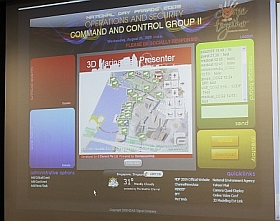New tech in action at Singapore parade

SINGAPORE--To facilitate operations and encourage greater public participation, the organizers of National Day Parade (NDP) 2009 have introduced new technologies to the event.
In use for the first time at the NDP this year, are an integrated dashboard for information sharing and screening of CCTV (closed-circuit television) shots, and the utilization of social media to reach to a wider audience.
These two new key technology features for the parade, as Singapore celebrates its 44th birthday on Aug. 9, were designed and built in-house by full-time national servicemen (NSFs).
Goh Zi Yang Eric, deputy chairman of communications and multimedia committee, said his committee's manpower increased about 50 percent this year over last year.
"We apply what we learn in military training to NDP and we take it as an operation platform for us to leverage on what we have learnt," said the army regular. This would also help reduce the cost to engage a service provider.

The team started planning early this year, keeping in mind, the idea to build a single Web-based portal to handle different tasks, such as CCTV monitoring, data sharing and updating of what happens as the parade progresses, he added.
This integrated portal works on a single computer, instead of dedicated computers, which in previous years, handled each task separately.
Goh said the portal made it easier for the team in the command center to work. The portal was built by the team itself. It features a 3D mapping application covering the CCTV locations and lets the command center personnel view shots off the camera within the map. Previously, only a 2D map was used.
This new addition will aid the commander to visualize and dispatch mobile forces patrolling the area, Goh explained.
Goh Zi Meng Esmond, officer-in-charge of operations and security operations, said the level of technology integration this year is much higher than in 2008.
Data transfer between the two servers in the parade area is possible via a shared-server concept through a wireless connection. Personnel from the mobile forces working in the vicinity carry PDAs that let them upload and download files and e-mail through the network.
Although communicating via phones would be faster and simpler, data sharing is the main use of the portal and shared server, explained Esmond Goh, who is also a regular in the army.
To support the wireless connection over the area, more than 60 access points (APs) are set in 14 hotspots at locations near the parade area, such as Marina Square, the Fullerton Hotel and United Overseas Bank Building (UOB).
According to Eric Goh, the wireless connection at UOB is dedicated to a medical team, enabling medical staff to send and receive information easily through the portal as well as via wireless means.
Because the wireless network is secured, the public would not be able to access it as the SSID (service set identifier) is hidden and only authorized personnel can set their laptops to access it.
Lee Mei Lian, officer-in-charge of the communications and multimedia committee, said with such a huge load on the network, the technical team has a program specifically to monitor the network. While SingTel has provided the bandwidth for the parade and placed backups, the program allows authorized staff to balance the bandwidth's usage.
Apart from communicating over the wireless network, a few hundred two-way radios, or TRS, with island-wide coverage are also employed this year, said Lee.
In addition, this year's NDP organizers have also installed a GPS tracking system into the TRS, allowing real-time tracking of these devices around Singapore, she added.
Eric Goh said one example of the use of this feature was when the organizers hosted special previews of the parade in July for Primary 5 students. Officers using the GPS-equipped TRS were dispatched to each school to facilitate the transporting of the schoolchildren to the show. GPS allowed the tracking of the buses and also let the command center give advice in advance, on issues such as avoiding traffic congestions.
Lee added that as the TRS works on a separate frequency, there have not been issues with frequency interference so far. Despite this, a frequency monitoring team is also present this year.
Social media plays a part
Eric Goh said with social media use growing stronger, the committee decided to utilize social networks and entertainment portals--Facebook, Twitter, YouTube and Flickr--as well as blogging to achieve a "wide reach" to the public.
- Two servers powering the entire system
- Over 60 access points
- 14 external hotspots
- Few hundred two-way radios
- 91 CCTVs
- 60 personnel in communications team
- 10 personnel in operations and security team
- 60 personnel working on new media
- Over 100 laptops, of which 40 are located in
the command center - 230 schools participating in NDPeeps portal
- Over 600 followers on Twitter
- About 15,000 fans on Facebook
- 3 Web casts
- 5 camera angles at Marina Bay
- 8 heartlands celebrate in video feeds
The committee designed a special portal, NDPeeps, housing the various social networks and entertainment portals within a single site. With the aim to "engage more people", Eric Goh demonstrated how the portal works to drive more participation from the public.
Apart from links to the social networks and entertainment sites, the portal also allows people to "write reflections" to express what National Day means to them.
One interesting addition are the video feeds embedded into NDPeeps, in addition to the common video feed in the NDP2009 main page showing what is telecast over national television. One of these feeds features the celebration going on at the parade area in Marina Bay, while the other focuses on celebrations in residential heartlands across the nation.
The Marina Bay video feed can be seen from five different camera angles, which users choose freely, whereas the heartlands' celebration will feature eight different venues.
Eric Goh said for the feeds to be streamed to the public smoothly and quickly, peer-to-peer (P2P) technology is used so users can tap onto each other's processing power and network bandwidth. This would allow users to stream the videos faster as traffic increases, he added.
Celebrity bloggers, Mr Brown from mrbrown.com and 933FM deejay Ding Zhi Yong, as well as a group comprising NSFs will also link their blog sites to NDPeeps. The portal and its contents are managed by NSFs, while the personal reflections on the site are user-generated.
Challenges faced
Esmond Goh said the organizers initially encountered difficulties configuring the PDAs to work with the command center portal as the devices were running on an old OS that lacked a native upload client and therefore did not support the uploading of files.
His team solved the problem by upgrading the OS to Windows Mobile version 6.5, allowing Opera Mobile to be installed on the PDAs as a client to enable the uploading and downloading of files.
For the communications team, Lee identified resources management as its main difficulty. Even with 90 percent of the equipment being sponsored, reduced sponsorships this year due to economic conditions made it more challenging to allocate resources.
The integrated dashboard used by the command center was one way to get around the problem of having to work with fewer laptops, since it allows a single computer to access different tasks, Lee said.
Based in Singapore, Konrad Foo is an intern with ZDNet Asia.